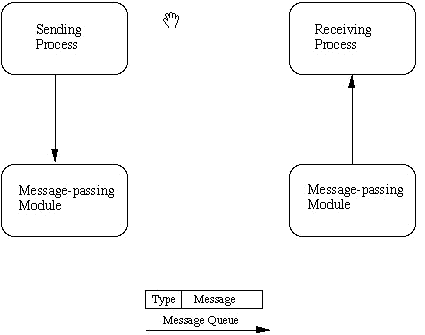SATINDER.EMBDEVELOPER
IPC:Message Queues:<sys/msg.h>
The basic idea of a message queue is a simple one.
Two (or more) processes can exchange information via access to a common system message queue. The sending process places via some (OS) message-passing module a message onto a queue which can be read by another process . Each message is given an identification or type so that processes can select the appropriate message. Process must share a common key in order to gain access to the queue in the first place (subject to other permissions — see below)
Basic Message Passing IPC messaging lets processes send and receive messages, and queue messages for processing in an arbitrary order. Unlike the file byte-stream data flow of pipes, each IPC message has an explicit length. Messages can be assigned a specific type. Because of this, a server process can direct message traffic between clients on its queue by using the client process PID as the message type. For single-message transactions, multiple server processes can work in parallel on transactions sent to a shared message queue.
Before a process can send or receive a message, the queue must be initialized (through the msgget function see below) Operations to send and receive messages are performed by the msgsnd() and msgrcv() functions, respectively.
When a message is sent, its text is copied to the message queue. The msgsnd() and msgrcv() functions can be performed as either blocking or non-blocking operations. Non-blocking operations allow for asynchronous message transfer — the process is not suspended as a result of sending or receiving a message. In blocking or synchronous message passing the sending process cannot continue until the message has been transferred or has even been acknowledged by a receiver. IPC signal and other mechanisms can be employed to implement such transfer. A blocked message operation remains suspended until one of the following three conditions occurs:
- The call succeeds.
- The process receives a signal.
- The queue is removed.
- Initialising the Message Queue
The msgget() function initializes a new message queue:
int msgget(key_t key, int msgflg)
It can also return the message queue ID (msqid) of the queue corresponding to the key argument. The value passed as the msgflg argument must be an octal integer with settings for the queue’s permissions and control flags.
The following code illustrates the msgget() function.
#include <sys/ipc.h>;
#include <sys/msg.h>;
...
key_t key; /* key to be passed to msgget() */
int msgflg /* msgflg to be passed to msgget() */
int msqid; /* return value from msgget() */
...
key = ...
msgflg = ...
if ((msqid = msgget(key, msgflg)) == –1)
{
perror("msgget: msgget failed");
exit(1);
} else
(void) fprintf(stderr, “msgget succeeded");
...




